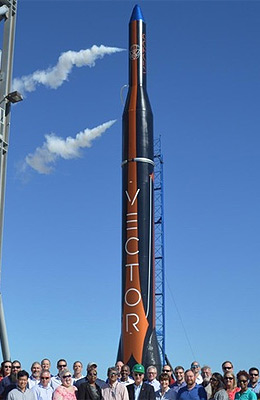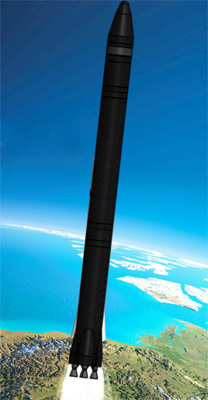Thank you very much for visiting Gunter's Space Page. I hope that this site is useful and informative for you.
If you appreciate the information provided on this site, please consider supporting my work by making a simple and secure donation via PayPal. Please help to run the website and keep everything free of charge. Thank you very much.
Vector

Vector-R Block 0.1 [Vector Space Systems] |

Vector-R (mockup) [Vector Space Systems] |

Vector-H [Vector Space Systems] |
Vector is a small liquid fueled orbital launch vehicle, which is being developed by Vector Space Systems. Both stages use a proprietary densified Liquid Propylene (LPROP) and LOX as propellants.
The Vector launch vehicle was originally developped by Garvey Aerospace as the NLV-20 nanosat launch vehicle, which was later renamed Wolverine. With a stretched stage 2, it was developed into the Vector-R.
Vector-R is 13 m tall and 1.1 m in diameter and is build on carbon fiber structures. With a lift-off weight of 6060 kg it can put a 50 kg in a low inclination orbit or 25 kg into a polar orbit.
The vehicle uses three pressure fed engines of each 25 kN thrust for the first stage and one pressure fed engine of 3.5 kN thrust for the second stage. The first stage is designed to be reused. The baseline flight takes the first stage downrange 100 km until stage separation. The first stage deploys a parachute and aerial recovery and returns to the launch site for re-use. An optional electric powered third stage is also planned for higher performance at higher altitudes.
Vector-R is designed for small payloads up to 50 kg. CubeSats will be launched without using deployers.
Planned launch sites are Kodiak (PCSA) for 90-100° orbits and Cape Canaveral AFS SLC-46 for 28-58° orbits. Also a barge launch capability off the coast of California is considered.
Vector Space Systems has already begun engine-level static fire testing and is working toward the start of sub-orbital test flights that will pathfind operations and manifest key technology experiments in Q3 2016, followed by large-scale sub-orbital test flights of a aluminium structure Block 0 prototype in 2017 and composite tank vehicle orbital launches in 2018.
An improved Vector-H is also planned with a payload capacity of 290 kg to low earth orbit. It is 16 m tall and has a lift off weight of 8690 kg.
Vector-H features a stretched stage one with three LP-3 engines, also reusable, a full diameter stage 2 and reduced inert mass fractions. The optional electric powered third stage is also available. The first launch is planned for late 2020 or early 2021.
First launch tests involve low altitude flights of a full size aluminium air-frame called Vector-R Block 0.1 with the technology of the Garvey/Vector P19 rocket and only one engine. Launch site is a rail launcher at the FAR site at Mojave.
In August 2019, Vector announced that, due to financial issues, it is undertaking a pause of operations. A core team was evaluating options on completing the development of the company’s Vector-R small launch vehicle. Reportedly the performance margins of the Vector-R were too low to put an payload into orbit. The development of Vector-H has been put on hold. In October 2020, the new owner announced to continue work with suborbital and later orbital launches planned. They hope to launch a Vector-R within 12 to 15 months.
The Redesigned Vector-R uses kerosene as fuel and new engines called Tanner Sea Level on stage 1 and one Tanner Vacuum on stage 2
| Version | Stage 1 | Stage 2 | Stage 3 |
|---|---|---|---|
| Vector-R Block 0.1 (P-19h) | Stage 1 frame / 1 × ? | Dummy Stage 2 | - |
| Vector-R | Stage 1 / 3 × LP-1 | Stage 2 / LP-2 | - |
| Vector-RE1 | Stage 1 / 3 × LP-1 | Stage 2 / LP-2 | Electric Stage |
| Vector-H | Stretched Stage 1 / 3 × LP-3 | Widebody Stage 2 / LP-4 | - |
| Vector-HE1 | Stretched Stage 1 / 3 × LP-3 | Widebody Stage 2 / LP-4 | Electric Stage |
| Vector-R | Stage 1 / 4 × Tanner-Sea-Level | Stage 2 / Tanner-Vacuum | - |
| Vector-H | Stage 1 / 8 × Tanner-Sea-Level | Stage 2 / 2 × Tanner-Vacuum | - |
| Performance (kg) | LEO | LPEO | SSO | GTO | GEO | MolO | IP |
|---|---|---|---|---|---|---|---|
| Vector-R | 60 | - | - | - | - | ||
| Vector-RE1 | 30 | - | - | - | - | ||
| Vector-H | 290 | - | - | - | - | ||
| Vector-HE1 | - | - | - | - | |||
| Vector-R | 320 | 200 | - | - | - | - | |
| Vector-H | 950 | 700 | - | - | - | - |
No. TypNo Type Date LS Payload
1 1 Vector-R Block 0.001 03.05.2017 FAR * (P19h R&D) 2 1 Vector-R Block 0.002 03.08.2017 Cam * (R&D) Planned Launch sites: Cam = Spaceport Camden, Woodbine, Georgia, USAFAR = FAR Site, Mojave, California, USA
Kd = Pacific Spaceport Complex - Alaska (Kodiak Launch Complex), Kodiak Island, Narrow Cape, Alaska, USA
Va = Vandenberg Air Force Base, California, USA
WI = Mid-Atlantic Regional Spaceport (MARS), Wallops Island, Virginia, USA

References:
- Vector Space Systems: Vector Launch Vehicle - Vehicle Specifications
